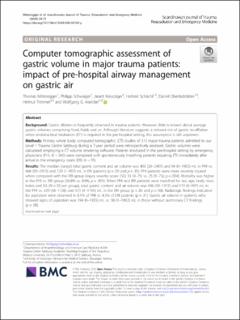| dc.contributor.author | Mitteregger, Thomas | |
| dc.contributor.author | Schwaiger, Philipp | |
| dc.contributor.author | Kreutziger, Janett | |
| dc.contributor.author | Schöchl, Herbert | |
| dc.contributor.author | Oberladstätter, Daniel | |
| dc.contributor.author | Trimmel, Helmut | |
| dc.contributor.author | Voelckel, Wolfgang Georg Cornelius | |
| dc.date.accessioned | 2021-03-15T14:18:02Z | |
| dc.date.available | 2021-03-15T14:18:02Z | |
| dc.date.created | 2020-11-17T09:05:36Z | |
| dc.date.issued | 2020-07 | |
| dc.identifier.citation | Mitteregger, T., Schwaiger, P., Kreutziger, J. et al. (2020) Computer tomographic assessment of gastric volume in major trauma patients: impact of pre-hospital airway management on gastric air. Scandinavian Journal of Trauma, Resuscitation and Emergency Medicine, 28, 72 | en_US |
| dc.identifier.issn | 1757-7241 | |
| dc.identifier.uri | https://hdl.handle.net/11250/2733471 | |
| dc.description.abstract | Background
Gastric dilation is frequently observed in trauma patients. However, little is known about average gastric volumes comprising food, fluids and air. Although literature suggests a relevant risk of gastric insufflation when endotracheal intubation (ETI) is required in the pre-hospital setting, this assumption is still unproven.
Methods
Primary whole body computed tomographic (CT) studies of 315 major trauma patients admitted to our Level 1 Trauma Centre Salzburg during a 7-year period were retrospectively assessed. Gastric volumes were calculated employing a CT volume rendering software. Patients intubated in the pre-hospital setting by emergency physicians (PHI, N = 245) were compared with spontaneously breathing patients requiring ETI immediately after arrival in the emergency room (ERI, N = 70).
Results
The median (range) total gastric content and air volume was 402 (26–2401) and 94 (0–1902) mL in PHI vs. 466 (59–1915) and 120 (1–997) mL in ERI patients (p = .59 and p = .35). PHI patients were more severely injured when compared with the ERI group (injury severity score (ISS) 33 (9–75) vs. 25 (9–75); p = .004). Mortality was higher in the PHI vs. ERI group (26.8% vs. 8.6%, p = .001). When PHI and ERI patients were matched for sex, age, body mass index and ISS (N = 50 per group), total gastric content and air volume was 496 (59–1915) and 119 (0–997) mL in the PHI vs. 429 (36–1726) and 121 (4–1191) mL in the ERI group (p = .85 and p = .98). Radiologic findings indicative for aspiration were observed in 8.1% of PHI vs. 4.3% of ERI patients (p = .31). Gastric air volume in patients who showed signs of aspiration was 194 (0–1355) mL vs. 98 (1–1902) mL in those without pulmonary CT findings (p = .08).
Conclusion
In major trauma patients, overall stomach volume deriving from food, fluids and air must be expected to be around 400–500 mL. Gastric dilation caused by air is common but not typically associated with pre-hospital airway management. The amount of air in the stomach seems to be associated with the risk of aspiration. Further studies, specifically addressing patients after difficult airway management situations are warranted. | en_US |
| dc.language.iso | eng | en_US |
| dc.publisher | BioMed Central | en_US |
| dc.rights | Navngivelse 4.0 Internasjonal | * |
| dc.rights.uri | http://creativecommons.org/licenses/by/4.0/deed.no | * |
| dc.subject | traumatologi | en_US |
| dc.subject | akuttmedisin | en_US |
| dc.subject | traumepasienter | en_US |
| dc.title | Computer tomographic assessment of gastric volume in major trauma patients:impact of pre-hospital airway management on gastric air | en_US |
| dc.type | Peer reviewed | en_US |
| dc.type | Journal article | en_US |
| dc.description.version | publishedVersion | en_US |
| dc.rights.holder | (C) The Author(s). 2020 | en_US |
| dc.subject.nsi | VDP::Medisinske Fag: 700::Klinisk medisinske fag: 750::Traumatologi: 783 | en_US |
| dc.source.pagenumber | 6 | en_US |
| dc.source.volume | 28 | en_US |
| dc.source.journal | Scandinavian Journal of Trauma, Resuscitation and Emergency Medicine | en_US |
| dc.identifier.doi | 10.1186/s13049-020-00769-y | |
| dc.identifier.cristin | 1848623 | |
| dc.source.articlenumber | 72 | en_US |
| cristin.ispublished | true | |
| cristin.fulltext | original | |
| cristin.qualitycode | 1 | |

